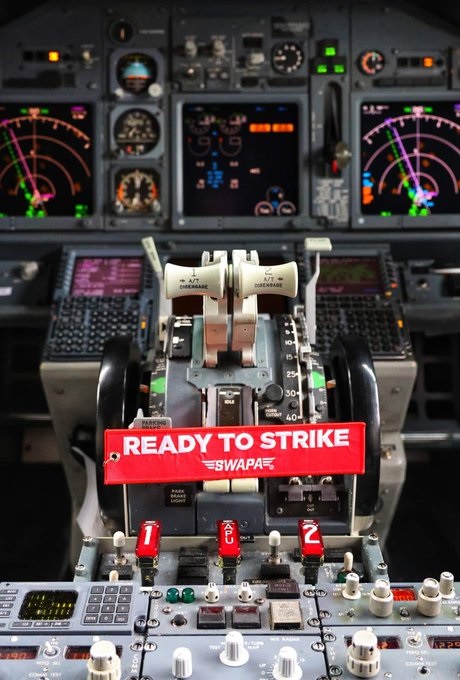


Many Unions ans associations of Aviation employees incluing Pilots and Mechanics are increasing the pressure on the carriers and operators for better Pay-packages , as Aviation growth shows upward trends in last one and half years. Signs are cystal clear that air travel is recovering , and the demand of trained aviation staff is very high.
U.S. Government Accountability Office (GAO) came forward and carried out a study to find out the Demand-Supply relation in aviation, as it says ,
The demand for commercial airline travel rebounded after the COVID-19 pandemic, heightening the need for pilots and mechanics. But while the number of pilots has grown in recent years, there may not be enough of them to meet airlines' needs in the future. There also may not be enough mechanics to maintain airplanes.
Recently, Southwest pilots voted to approve a strike, and they were seen walking through the airport in Orlando, while picketing. This implies , the airline employees understand the demand of the moment and they want a better contract than the previous.

These kind of Picketing or strike has often disrupted the flight schedules , increasing passenger dissatisfaction , which again is a big setback to the airlines , for the services they provide.
The solution to these issues has prompted carriers to accept the demands of the employees , improve their contracts and offer lucrative packages to the pilots of rival airlines.
Government Accountability Office (GAO) says,
To make aviation careers more attractive, airlines and maintenance facilities are offering higher pay to these workers. Airlines are also creating flight schools to train more pilots.
We looked at some of the workforce challenges facing commercial aviation, and steps the industry is taking to address them.
The U.S. Government Accountability Office is a legislative branch government agency that provides auditing, evaluative, and investigative services for the United States Congress. It is the supreme audit institution of the federal government of the United States.
Post Covid -19 aviation depression and during the peak of demand, Carriers like Alaska Airlines and few other have already lost pilots who jumped to Delta and other carriers offering better. As per pilots , expecting a pay raise of at least 50% in the new contract should not be a big ask.
However, GAO says ,
Current pilot supply—as measured by the number of individuals qualified to be U.S. passenger airline pilots—grew from 2017 through 2022. Enrollments in pilot training schools also increased in recent years.
Based on the Federal Aviation Administration's (FAA) forecasts and pilot certification data, the number of these pilots under the current mandatory retirement age of 65 may increase over the next 20 years.
GAO's study could not establish a futuristic Demand vs Supply graph, which is again driven by various factors like Travel demand, economic condition, availability of trained Aviation manpower etc.
Its study read,
However, the extent to which projected supply would exceed or fall short of industry's demand for pilots is unknown given uncertainties surrounding future demand. Publicly available data on hiring, employment, and wages indicate strong current demand for pilots.
Meeting that demand has been particularly difficult for regional airlines—which generally serve smaller communities—and has, according to them, affected their operations.

Note: Pilots age 65 and over are no longer eligible for employment with scheduled U.S. passenger airlines, but could work as pilots or instructors elsewhere.
GAO has acknowledged the number of certified Mechanics , those gets caertificates from the Federal Aviation Administration (FAA) , It said ,
The number of people newly certificated by FAA to be aircraft mechanics grew from 2017 through 2022. Less is known about how many mechanics enter or exit the aviation industry each year and the extent of demand for aircraft mechanics. Nevertheless, aviation businesses GAO interviewed reported challenges maintaining sufficient numbers of mechanics.
It also said that airlines and stakeholders are increasing the Pay - package of the Pilots and Mechanics ,
Aviation industry stakeholders have taken steps to address workforce supply concerns. Airlines and repair stations are increasing pay for pilots and mechanics. For example, several regional airlines raised pay substantially in 2022. Airlines are also creating flight schools. FAA is undertaking efforts to support industry workforce development, including awarding grants to attract young people to aviation careers.
The aviation industry has raised questions about whether the demand for commercial airline pilots and aircraft mechanics may exceed supply in the future. Industry's demand for pilots and mechanics is driven by a number of factors. These include projected demand for air travel and the number of aircraft that airlines expect to use to fulfill that demand, as well as anticipated workforce attrition and retirements.
The FAA Reauthorization Act of 2018 includes a provision for GAO to study the aviation and aerospace workforce of the future, including the current and future supply of individuals in the workforce. This report examines the supply of and demand for
1) commercial airline pilots and
2) aircraft mechanics; and examines
3) actions the aviation industry and FAA have taken to address workforce supply concerns, among other objectives.
GAO reviewed government and industry labor supply, employment, and wage data for 2017 through 2022 using the most recent data available at the time of the analyses; and several government and private sector aviation forecasts.
GAO reviewed relevant federal laws and regulations and FAA documentation including rulemaking documents. GAO interviewed officials from FAA and representatives from a non-generalizable sample of 25 aviation industry stakeholders. These included airlines, collegiate flight schools, aviation maintenance schools, repair stations, labor unions, aviation consultants and academics, and industry associations.
Display Picture : Southwest Airlines Pilots Association
Related news....
